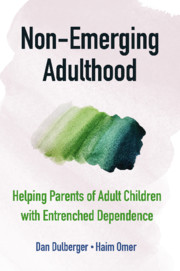Book contents
- Non-Emerging Adulthood
- Non-Emerging Adulthood
- Copyright page
- Contents
- Introduction
- 1 The Adult-Child
- 2 NVR and Accommodation
- 3 The Intervention
- 4 Suicide Threats
- 5 Helping Parents of Children and Adolescents at Risk of Failure to Emerge
- 6 Addressing Entrenched Dependence in Special Contexts
- 7 Survival Mode
- Conclusion
- Bibliography
- Index
- References
Bibliography
Published online by Cambridge University Press: 05 May 2021
- Non-Emerging Adulthood
- Non-Emerging Adulthood
- Copyright page
- Contents
- Introduction
- 1 The Adult-Child
- 2 NVR and Accommodation
- 3 The Intervention
- 4 Suicide Threats
- 5 Helping Parents of Children and Adolescents at Risk of Failure to Emerge
- 6 Addressing Entrenched Dependence in Special Contexts
- 7 Survival Mode
- Conclusion
- Bibliography
- Index
- References
Summary

- Type
- Chapter
- Information
- Non-Emerging AdulthoodHelping Parents of Adult Children with Entrenched Dependence, pp. 142 - 146Publisher: Cambridge University PressPrint publication year: 2021

